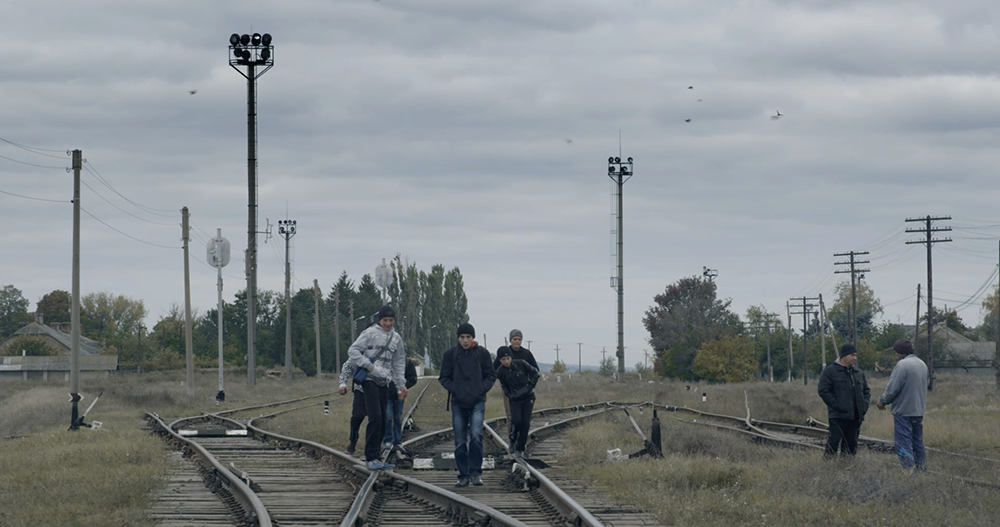By Lauren Hurrell
Directed by Matthew Mishory
Sevilla Festival de Cine Europeo review
In this cinematic portrait, Matthew Mishory and a small crew explore the history of the derelict town of MărculeÈ™ti, in the northern Moldova, which Mishory describes to be the “poorest and least visited country in Europeâ€. We learn from the town’s people in the film that MărculeÈ™ti was once a vibrant Jewish village, before the Jews were shot in 1941, resulting in the losses of its people, its energy and its industry, which caused many of its people to leave the town to go abroad with the hopes of finding a better life. The title of the film is very fitting for this documentary, in which Matthew Mishory successfully captures the ghostly presence, or absence, that history has left behind.
Throughout the film, often recorded on handheld cameras due to a lack of electricity, there are sequences of derelict buildings and broken windows, as the people of the town go about their daily errands; a working man passes slowly by on horse and cart and passing tractors trundle along dusty paths, as trees sway lazily in a haunting breeze, but the sound that never seems to stop is the singing of the birds. This lethargic imagery captures the undeveloped, inactive state of the small town, as Mishory focuses lengthily on the sleepy, rural landscape surrounding the derelict area, using long panning shots to capture the heavy grey skies and unrelenting flat light of daytime that sits anxiously above still, barren land. The eeriness that lurks about the town is the evidence that suggests Mărculești wasn’t always this way.
Mishory strikes a careful balance of depicting this derelict town and interspersing the visual footage with opportunities to meet the town’s people. Throughout the documentary, we meet several of the current residents of Mărculești, who share their conflicting views on the history of their town, describing the effects of the Holocaust on their community and how it became what it is now. We learn about the realities of very poor families, like Elena and her children, who can’t afford to heat their own homes in the winter. Instead, they rely on the sun shining through their windows to warm their homes, expressing to Mishory their gratitude to the Jews who had once built the houses accordingly.

Through the use of interviews, many of the inhabitants of this town reveal a sense of contentment in their lifestyles, however, the sense of lethargy seems to soak deep down into the heart of MărculeÈ™ti, and its people. The film crew ask one individual, “What would you like to happen to this town?†In response, the woman simply replies: “to live well and to have peace.â€
A real strength in the film is the way in which Mishory succeeds in capturing the essence of Mărculești’s children, who seem to represent a new sense of hope. These children do not understand why the Jews were killed, and uphold an innocent yet educated perspective on the tragic past as something that should never happen again. Mishory’s emphasis on the stillness, loss and loneliness of the town sturdily emphasises the spirit of the children in contrast. This is executed particularly well with the use of the voice-over of young teenagers discussing their after-school activities; doing homework, watching television, singing songs etc., while we uncomfortably realise the lack of opportunities that these young people have in order to fulfil themselves.
On the contrary, during an interview, an elderly woman raises the poignant question to Mishory: “Why do you ask about the past but not the present?†She then shares her moving experience of childhood during wartime, and contrasts this gloomy period of her life to recent times when she would cross the bridge near her home, only to see the children on their daily stroll to school, “dressed up and cleanâ€, which brings her to tears in the film as she reminisces; it gave her hope, happiness and relief that, unlike her, these children would not grow up in wartime.
Matthew Mishory’s documentary reveals an ill-fated realisation that the town may never return to what it once was, a problem suggested by the way in which the children are seen to be the future, a ‘new hope’ for MărculeÈ™ti, and yet, as we learn from personal interviews with the town’s residents, it is the young people who keep leaving to find better lives with more opportunities elsewhere. Mishory demonstrates this sense of stasis using a cyclical structure in the film, as it begins with a shot of a boy silently taking in the landscape while the cameras capture the rural environment, which is also how the documentary concludes. The film maintains a dusty, colour-washed aesthetic throughout, with fleeting moments of natural beauty and a satisfied yet disjointed sense of community, essentially personifying the town of MărculeÈ™ti likewise, whilst representing its stasis continually through the unrelenting, inconspicuous birdsong.
Recommended Viewing on FilmDoo:
(UK & Ireland only)









